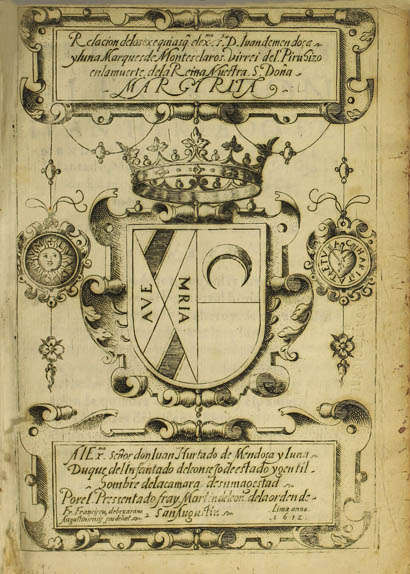
Libraries
Libraries
Relación de las exequias que el excelentísimo señor don Juan de Mendoza y Luna, marqués de Montesclaros, virrey del Perú, celebró en honor de la muerte de la reina Nuestra Señora doña Margarita
Printed in 1613 by Pedro de Merchán, as head of Francisco del Canto’s workshop, the book recounts the funeral services organized in Lima by the viceroy of Peru to commemorate the first anniversary of the death of Margarita de Austria, wife of King Felipe III and queen. of Spain from 1599 until his death. Furthermore, this volume stands out for two reasons.
The first: the text allows us to appreciate the work of Francisco Bejarano, an Augustinian friar and disciple of Mateo Pérez de Alesio, as an engraver. The Funeral Relationship contains in the frontispiece the first shield engraved in the Lima presses: the shield of Viceroy Juan de Mendoza y Luna signed by Bejarano in 1612. Ricardo Estabridis (p. 311) describes this piece:
«The shield is composed, half cut and split, half right-handed reed with the inscription AVE MARIA. The sinister cut with a waning moon in the upper corner and the lower one in silver, all bordered with mannerist cardboard. It has a marquis crown as a ring at the top ».
The second: the text includes a poem by Pedro de Oña. In «Canción real al Excelentísimo señor don Juan de Mendoza y Luna, marqués de Montes Claros, virrey del Pirú», Oña used, according to Sarissa Carneiro, the most prestigious forms of the poetic panegyric at the beginning of the seventeenth century: the canción and the narrative poem written in octavas reales. Thus, the Italian Petrarchan song was the form chosen by Oña to praise the Marquis for his actions in the celebration of royal funerals in the Viceroyalty of Peru.
Daphne Cornejo
Proyecto Estudios Indianos
Digital Resources
Carneiro, Sarissa (2018). Encomio y cortesanía en el Virreinato del Perú: la «Canción real panegírica al marqués de Montesclaros» (1607) de Pedro de Oña. Hipogrifo, 6(1), 31-51
Estabridis, Ricardo(2002). El grabado en Lima virreinal: documento histórico y artístico (siglos XVI al XIX). Lima: Fondo Editorial Universidad Nacional Mayor de San Marcos

